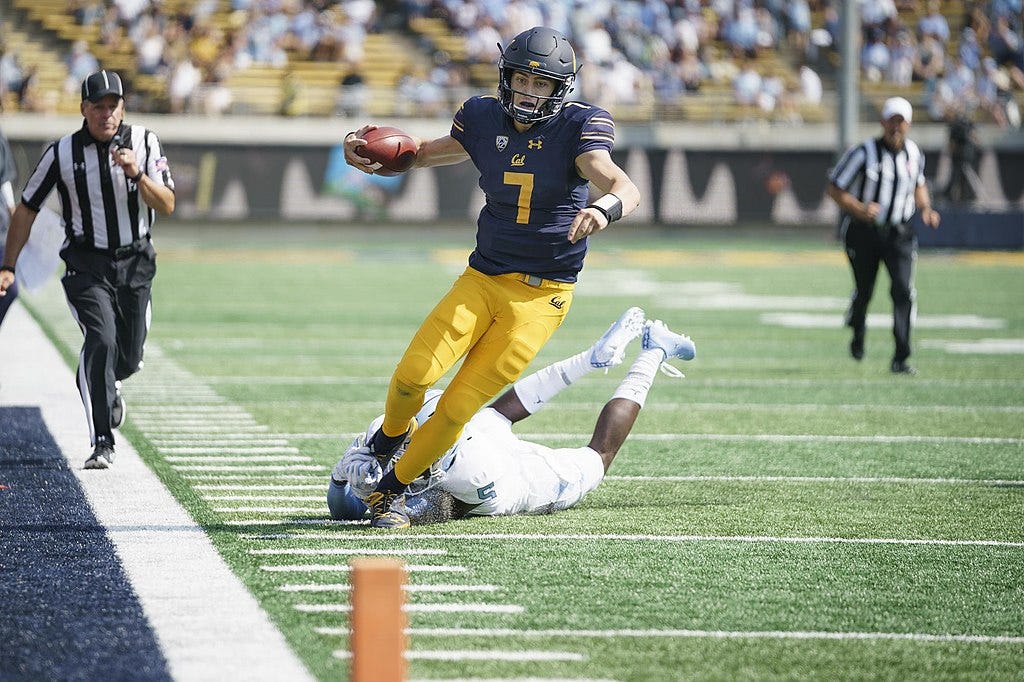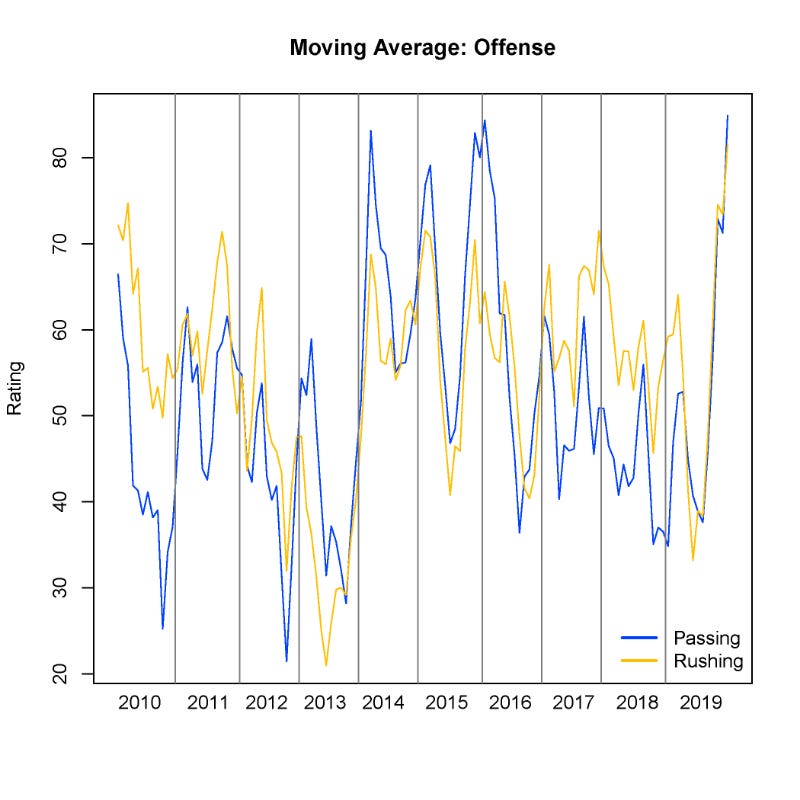Cal Football 2010s in Review: The Rise and Fall (and Rise?) of the Cal Offense
Hold on to your butts.

Photo credit: Kelley L Cox / CC BY-SA (https://creativecommons.org/licenses/by-sa/4.0)
Since we remain stuck in a sports-less hellscape, we have been looking back at Cal football’s turbulent 2010s. For all 124 games in the decade, we asked our readers to rate the team’s performance on a variety of categories. Using those ratings we covered the best of the decade and the worst of the decade. Next we turn our attention away from aggregate numbers and towards specific categories. First up, the offense.
It was a tumultuous decade for the Cal offense (to be fair, it was a tumultuous decade for everything Cal football-related). Tedford’s offense started the decade in clear decline, then Sonny Dykes broke pretty much every school record on offense, and then Wilcox presided as Beau Baldwin did…whatever we were doing on offense in 2018, and finally Chase Garbers ended the decade with a tantalizing flourish of offensive brilliance. To display the trends over time, I’ve plotted the moving average below for two categories: passing offense and running offense. The average is calculated from the game of interest, the preceding two games, and the following two games. Below I’ve plotted passing in blue and running in gold.

To say that Tedford had inadequately prepared his backup QBs for playing time in the 2010s is an incredible understatement. Passing offense cratered in 2010 after Riley’s injury. The ground game declined soon thereafter as opposing defenses smothered a one-dimensional offense. The offense recovered in 2011 under Zach Maynard (although a pair of 5-turnover games led to that midseason lull in the passing game) and behind the thunder-and-lightning pairing of CJ Anderson and Isi Sofele. Alas, that returning cast of characters was unable in 2012 to achieve the same moderate success they had in 2011. The team’s midseason collapse and Maynard’s season-ending injury brought the Cal offense to the lowest lows of the decade, thus paving the way for Sonny Dykes to rejuvenate the Cal offense.
Despite flashes of brilliance, that offensive rejuvenation did not happen in 2013. By 2014, however, the Cal passing game had achieved some of the highest highs we would see in the decade. Interestingly, the ground game was pretty good in the Sonny Dykes era, but it was about as good as it was during the Tedford and Wilcox eras. Despite the rise of the Cal offense, Sonny Dykes’ offenses always seemed to perform best at the start of the season and then decline over the course of the year. This pattern persisted through the 2014, 2015, and 2016 seasons.
When Justin Wilcox took over in 2017, we reverted back to a familiar pattern we observed under Tedford: a decent running game and an inconsistent passing game. Fortunately, Wilcox was able to pair those lackluster offenses with excellent defenses. And then in 2019, we finally had an excellent defense coupled with a solid offense…as long as Garbers was healthy.
Cal Offense: Year by Year Averages
Three coaches. Three distinct flavors of Cal offense. Below I’ve listed the average score for each category during each year.
2010: passing - 41.04 (52.34 before Riley’s injury); rushing - 60.02 (67.35 before Riley’s injury)
2011: passing - 56.45; rushing - 60.36
2012: passing - 39.04 (lowest of the decade!) (43.97 before Maynard’s injury); rushing - 47.67 (48.33 before Maynard’s injury)
2013: passing - 43.64; rushing - 30.96 (lowest of the decade!)
2014: passing - 65.99; rushing - 59.90
2015: passing - 68.55 (highest of the decade!); rushing - 60.32
2016: passing - 56.20; rushing - 52.98
2017: passing - 51.48; rushing - 63.11 (highest of the decade!)
2018: passing - 42.44; rushing - 52.97
2019: passing - 54.27 (68.67 when Garbers was healthy); rushing - 58.19 (73.27 when Garbers was healthy)
Naturally, the three best years for passing were during the Sonny Dykes era. The best rushing years were split across the three coaches: Wilcox had #1 (2017), Tedford had #2 (2011), and Dykes had #3 (2015).
Tedford’s 2012 season was the worst for passing, followed by 2010, and then 2018. Wilcox avoided being part of one of the worst years for the ground game: 2013 was worst, followed by 2016 and 2012.
Now let’s highlight the best and worst games of the decade for the Cal offense according to our post-game ratings.
Best of the 2010s
2019: Cal 35, Illinois 20 (Passing: 89.50; rushing: 79.10)
Highlights: Garbers: 22/31, 272 passing yards (8.8 ypa), 4 passing TDs, 1 rushing TD; Brown: 120 yds (6.0 ypc); Polk (5 receptions for 105 yards)2019: Cal 24, LSJU 20 (Passing: 88.20; rushing: 79.20)
Highlights: Garbers: 20/30, 285 passing yards (9.5 ypa), 1 passing TD, 72 rushing yards (5.5 ypc), 1 rushing TD; Remigio: 157 rec. yards, 1 TD2015: Cal 55, Air Force 36 (Passing: 94.40 (highest of the decade!); rushing: 72.75)
Highlights: Goff: 25/37, 467 yards (12.6 ypa), 6 TDs; Treggs: 143 rec. yards, 1 TD; Lawler: 75 rec. yards, 3 TDs; Powe: 70 rec. yards, 2 TDs2018: Cal 49, OSU 7 (Passing: 80.00; rushing: 84.17)
Highlights: Garbers: 17/26, 234 yards (9.0 ypa), 3 TDs; Laird: 193 rushing yards (8.8 ypc), 2 rushing TDs, 48 rec. yards, 1 rec. TD2011: Cal 47, ASU 38 (Passing: 80.97; rushing: 85.23)
Highlights: Maynard: 19/26, 237 yards (9.1 ypa), 1 TD, 40 rushing yards (8.0 ypc), 1 TD; Sofele: 145 rushing yards (6.9 ypc), 1 TD; Anderson: 48 rushing yards (4.8 ypc), 2 rushing TDs, 74 rec. yards, 1 rec. TD
Honorable mention:
2010: Cal 35, UCLA 7 (Passing: 42.93; rushing: 92.11 (highest of the decade!))
Highlights: Vereen: 151 rushing yards (6.0 ypc), 2 rushing TDs, 51 rec. yards, 1 rec. TD; Sofele: 80 rushing yards (6.2 ypc); Jones: 48 rushing yards (48 ypc!)
Interestingly, only one Sonny Dykes performance made it into the top-five. While his offenses produced the top four passing scores of the decade (and 7 of the top 10), Wilcox’s best offensive performance tend to be very balanced with outstanding performances through the air and on the ground. That, and we may be grading on a curve due to lower expectations for Wilcox’s offenses and higher expectations for Dykes’ offenses. We’ll see if that trend is reversed when we look at the defense.
Worst of the 2010s
2019: Cal 0, Utah 35 (Passing: 9.15, rushing: 10.20)
Lowlights: Eighty three total yards.2013: Cal 13, LSJU 63 (Passing: 12.05, rushing: 11.98)
Lowlights: Failing to find the end zone again after going marching 80 yards down the field for a TD on the opening drive.2012: Cal 3, LSJU 21 (Passing: 19.82, rushing: 4.86 (lowest of the decade!))
Lowlights: 3 rushing yards on 28 carries.2018: Cal 3, UCLA 37 (Passing: 9.80; rushing: 22.10)
Lowlights: 4 consecutive possessions in the second half that ended with an interception, another interception, a fumble returned for a touchdown, and another fumble.2012: Cal 27, Utah 49 (Passing: 14.68; rushing: 17.78)
Lowlights: Taking 45 minutes to find the end zone against a team that was giving up 30 points per game in conference play.
Dishonorable mention:
2010: Cal 13, UW 16 (Passing: 5.59 (lowest of the decade!); rushing: 58.53)
Lowlights: the entire first-half drive summary for both teams: punt, punt, punt, turnover on downs, punt, punt, fumble, interception, interception, punt, punt, punt, punt, Cal field goal.
I know you were expecting the Cheez-Int Bowl to show up in the Worst of the 2010s category, but that was only the 8th-worst offensive performance of the year thanks to a moderately productive ground game.
What a wacky decade for Cal offense. From the despair of 2012-13 to the incredible heights of 2014-16, back to despair in 2018, and back to soaring heights at the end of 2019. I’m not sure any team in the country had a wilder offensive ride than we did in the 2010s. And the ride continues next time as we look at the Cal defense.
Cal Football 2010s in Review:


These are great stats but taken out of context with respect to each different coach's game strategy. Dykes put it all on his offense. Run up tempo and lots of plays and score more points than the other team, but don't worry about defense. Wilcox has a completely different game strategy. His is all about ball control. Offense moves slow, and grinds the clock. Great defense limits scoring. The end result of a Wilcox game is 22 points probably gets you a win. With a Dykes game you better be close to 50 or you're gonna lose. I can't comment on Tedford because while he is the winningest coach in CAL history, and I think he's an awesome coach, he was never consistent in his philosophy, and I think that's what did him in, along with an offensive playbook bigger than some pro teams...how can you ever get a back up QB ready? Joe Ayoob was a great example. Ayoob was a phenomenal athlete and awesome QB. When he played at SFCC coaches who recruited him said he was the best JC QB they had ever seen. So what happened? He was thrown to the wolves after one Spring because of an injury to a starter. He never had a chance in Tedford's system. In conclusion I have like all our coaches and their systems from Tedford till now. Sonny was fun and scored points. But my favorite is Justin Wilcox: he has a philosophy that doesn't change with the breeze like Tedford, and he is building a program designed to get better every year on both sides of the ball, unlike Dykes. Unlike CBS, I don't think we are going 11-1 this year but I think we will be improved again and a 10 win season is not out of the question. We could win 11 and we could win the PAC 12 Championship with our returning talent. Oregon is without Herbert and USC, with the best talent in the PAC12, still suffers from coaching issues in my mind. I for one am looking forward to our next season and I am more certain now than ever that Wilcox was the best hire we have made since Mike White. I just hope he likes Berkeley and we can keep him.
Furd is on the long slow decline for some reason. Maybe it's a burnout situation like Tedford. Maybe not. Maybe they were lucky for a number of years.